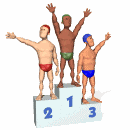|
How is the "Danish" system different than the "American" system?
Taken from an Article written by Steve Waller for the UP 4-H Club in Michigan.
|

|
A rank-order scoring system which awards the top exhibitor 1st, another 2nd, 3rd, etc. based on a score is called the “American System” or the “Peer System.” There may also be special categories such as “Top of Class”, “Best of Show”, etc. While the American system uses standards and requirements, it primarily uses the idea of competition between exhibitors, pitting one competitor against another to establish the rankings. In the Olympics, there can be only one gold, silver and bronze. That is the “American system” of awards.
In the “Danish System” (sometimes called the “Group Method”), exhibitors are measured against standards, not ranked against other exhibitors.
|
You are probably already familiar with the Danish system from school where A, B, C, D, & F grades are given. There might be 7 students with an A (meets excellent levels of ability) 12 with a B (above average levels), 14 with a C (average levels), etc. This, grouping by standards, is the Danish system. Since more than one exhibitor can meet the each level of standards, many more ribbons are handed out.
The Group Method or Danish System of evaluation recognizes the existence and allows for the relatively minor differences between two or more entries or performances of any two individuals or groups of individuals. The method promotes the educational objectives of 4-H and furthers the motto “Make the Best Better” by providing incentive for the maximum number of youth.
The group method attempts to distribute awards (ribbons, premiums, and public recognition) among the majority of those participating.
In 4-H, and in many junior classes of events in state and county fairs, most judging involves the Danish system of judging. In this system, the judges do not judge one person’s work by comparing it to another’s. Instead, a judge determines whether the exhibitors meet or exceed standards. Often a score sheet, available from the county 4-H office, is used to help the judge group exhibitors consistently.
Why is the Danish system used?
|
4-H uses the Danish system to judge youth exhibits to:
- · Help youth improve their project skills
- · Help them recognize their own efforts and accomplishments
- · Help them develop standards for future self-evaluation
- · Encourage them to continue in the project
- · Advise them on what they might learn next.
|
It’s not just about picking winners.
|
If young or novice exhibitors have to compete, American System, against older or veteran exhibitors, the chances of scoring at all would be very low. When the bar is set high, only the very best can truly compete, only the most experienced have even a chance of placing, discouraging novices from even entering the event.
Why not just have the top three competitors (we already know who they are) compete? The rest of us will just watch from the sidelines and let the event become a spectator sport instead of a participatory activity. Spectators don’t need to learn skills or set goals.
If novices are too intimidated to enter, the field narrows, the event dies.
For some young people and adults, participation itself is a bold and meaningful accomplishment. It can be a first step in improving self-esteem and encouraging individuals to continue to set new and higher goals. The Danish system encourages novices and intermediate exhibitors to do their best and strive to reach the highest levels even if they are not quite there yet. It helps people become better instead of just rewarding the best. It keeps the event populated and alive.
4-H boys and girls are more important than 4-H projects or awards. Learning how to do a project is more important than the project itself[1] and more important than being superior to others.
|

|
Danish gives every 4-H exhibitor the recognition deserved for the work that was done even if they haven’t yet reached the highest levels and helps young people recognize the need to set goals, improve their skills and “make the best better.” The Danish system rewards achievement more than individuals. The goal, especially for young people, is to cooperate to reach goals more than to compete against friends for ribbons.
Exhibitors are encouraged to help each other meet goals instead of competing against each other; to cooperate instead of compete. There is no reason to hope your fellow exhibitor does worse than you. In Danish you strive to join your “Blue Ribbon” team, not to beat them.
|
Hard-core competitors will steadfastly claim that the American System is the best way to “make the best better”, but in reality, the American System benefits just the one or few winners. Everyone else, the majority, especially the young, learn mostly about losing.
There is a very old saying: “He who sows sparingly will also reap sparingly, and he who sows bountifully will also reap bountifully” (II Cor. 9:6)[2]. In the Olympics (American System), we reap years of developmental work. For youth in county fairs (Danish System), we are sowing seeds, growing the next generation. Competitors who demand a high bar to reward only the best, even for youth, confuse reaping with sowing. Pick fruit too early and all you get is bitter fruit. For the sweetest fruit, patiently nurture your developing plants. Resist the temptation to reap too early. Reaping unripe fruit just because you are impatient, feeds no one. Endure a little hunger while fruit matures. Think more about the future than the present. That is how you reap bountifully.
What is the difference between Danish blue, red and white ribbons?
|

|
BLUE (excellent or A): The exhibit met high standards, an excellent rating. A blue is given to those who most nearly meet the highest standards established for the particular class or level of performance. Blue does not indicate perfection or superiority, but indicates a high degree (90% - 100%) of achievement toward the elements in the standards.
|
|

|
RED (good or B): Meets minimum standards, very good work. These entries rank good (80% - 89%) in relation to the standards or expected achievement. Either the general level of the accomplishment is less than excellent or enough shortcomings are found to cause the placing to drop from excellent to good.
|
|

|
WHITE (average or C): Meets standards well enough to be shown, but is only fair quality (70% - 79%). The white grouping contains entries found lacking and rate only an average, acceptable, or satisfactory rating for the standards established.
|
|

|
NO RIBBON: In Danish, no ribbon may be given if exhibits or individuals who for one reason or another fail to produce that level of achievement which can be reasonably expected in relation to the specific class or performance in which they are entered.
|
The advantage of the Danish system is that everyone whose work fulfills at least the minimum qualification can receive a ribbon of recognition. Theoretically, if all entries are judged to be excellent, all would receive blue ribbons. If all entries are judged to be poor, all would receive white ribbons or no ribbons at all. In Danish, ribbons signify levels of achievement, not placing.
|
|